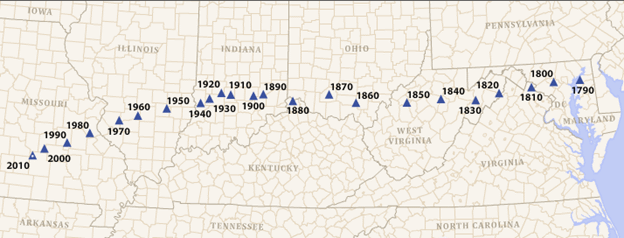THEY'RE AN AMERICAN BAND
Today's guest blogger is Professor Paul Jakus, of the Department of Applied Economics at Utah State University. We are honored to share his writing and research, and welcome other academics to contribute scholarly analysis of the band's history, as well.
Before the 2015 tour kicked off, @Lemuria analyzed where Phish has played over the years using Census divisions. He argued that not only does the west coast not get screwed; it gets more than its fair share of shows, while New England — the band’s home turf — is the region that gets shafted.
But analysis by Census divisions didn’t seem right to me. Census Divisions in the east are much smaller than those in the west, potentially distorting the analysis. Instead, why not calculate the geography of Phish shows the same way the Census Bureau determines the geographic center of the population?
What is a geographic population center? Think of a map of the U.S. as a table to be balanced on a single leg. Each person is a weight placed on the table where they live: In 1790, more Americans lived on or near the Atlantic coast; so, the leg on which the table is to be balanced must be placed very far to the east. (In 1790, this was in Kent County, MD.) To maintain the balance as Americans migrated west, the leg was moved further and further to the west. This Census Bureau map shows the westward movement of Americans with every Census since 1790:
We can do the same thing with Phish shows, using the latitude, longitude, and the number of shows played in any town. Restricting the analysis to North America, Phish has played at 322 known locations since 1987. I calculated the mean geographic center of Phish shows, by year, using the Census Bureau formulae with the number of shows (instead of population) as the weight. Holiday runs breaking over more than one calendar year were assigned to a single year.
In 1987, the geographic center was located just south of Burlington, VT. The well-known Telluride shows of 1988 pulled the geographic center further west (to near Canandaigua, NY), but then it reverted back to Stratton, VT, in 1989, as Phish spent that year closer to home. The band’s growth as a touring act can be seen when the geographic center rocketed over 600 miles to the west in 1990 (to near Utica, OH). The geographic center has since stayed firmly rooted in the heartland of Ohio, Indiana, and Illinois for most years. Prior to 2014, 1996 was the only year that the center moved west of the Mississippi River. But Lemuria’s central argument is correct: In 2014 and 2015, Phish played, on average, further west than it ever had.
What about that green dot near the 2014 and 2015 geographic centers? That turns out to be the 2010 geographic center of the U.S. population (Texas County, MO). Like it or not, Phish’s recent touring years have been almost perfectly balanced with the U.S. population. They’re an American band.
Comments
You must be logged in to post a comment.



 The Mockingbird Foundation
The Mockingbird Foundation
peace to you,
george
So my very flawed theory is that Phish knew that, which is why they don't do shows on trains, stagecoaches, or in Pahrump, NV.